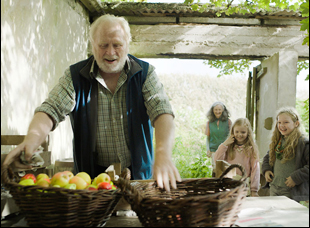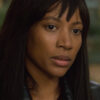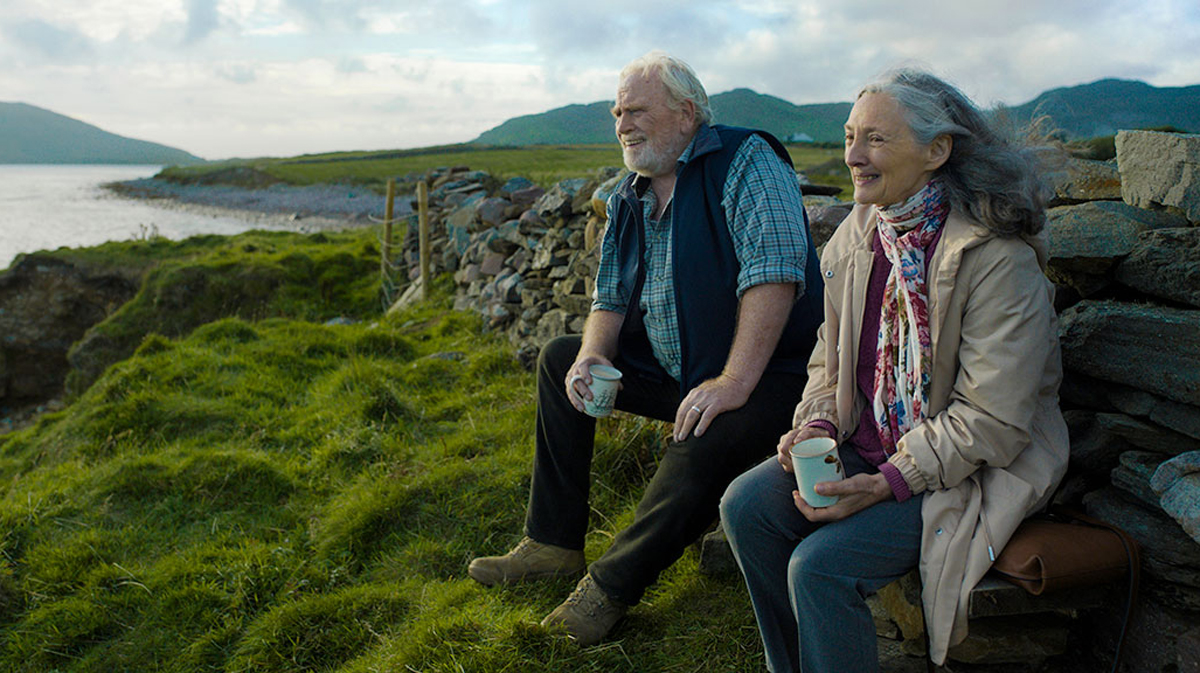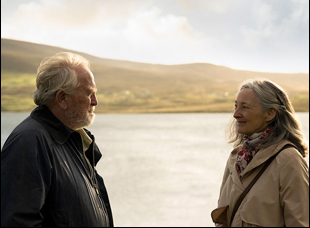In “My Sailor, My Love,” Annie (Brid Brennan) doesn’t know that when she’s fishing out an old captain’s outfit out of the trash that she’s picked up a life jacket. It’s one of many things she only gradually comes to realize after starting to take care of Howard (James Cosmo), whose daughter Grace (Catherine Walker) thinks he could use someone around the house to cook and clean with his seafaring days well behind him. He isn’t far from the ocean, living on the coast, but unlikely to dip back in, which is why he isn’t all that pleased at Annie’s arrival when he’s rather be left alone, unhappy when even his own daughter shows up on weekends. However, he recognizes Annie’s rescuing something more than the jacket when she retrieves his old fatigues, recognizing maybe he shouldn’t have offered a hundred dollars more a month to her not to darken his doorstep.
Forgiveness doesn’t come easily in the latest from Klaus Haro, though Annie is glad when she decides to return to Howard’s home while the same can’t be said for Grace, whose desire to see her father cared for seems like overcompensation for the love he‘s withheld from her for years. It makes for a juicy drama and a tender romance as Annie and Howard find a lot to like about one another and Grace only grows more alienated as the long and winding road it takes for her to come from the city to visit seems like it’s less and less worth the effort. However, director Klaus Härö makes the journey worthwhile in his English-language debut after making a series of charmers out of his native Finland such as “The Fencer” and “One Last Deal,” heading for the Irish coastline to witness the enlivening warmth Howard experiences upon opening his heart to another after it’s long been closed to his own flesh and blood.
Although Härö and writers Jimmy Karlsson and Kirsi Vikman wonder whether the family you make for yourself can equal the one you’re born into, the director aimed to prove it could be true at least on set, fostering a tight-knit production that radiates warmth on screen. With the film premiering this week at the Toronto Film Festival, he and Cosmo, who fits snugly into the part of a gentle giant, spoke about the bonds that had to be formed first by the cast and crew in order to come across on screen authentically, welcoming the unexpected and finding a location that could actually act as a physical emotional core.
Klaus Härö: Many, many years ago, I was talking to a couple of writers that I worked with before [saying], “There are so many stories about first love. Could we make something about love later in life? When you have a history, when you have a life, and that sort of gives you a different perspective.” So they started writing and they created these relationships, and with the producers, we said, “If we can, let’s go to Ireland.” I was born in the ’70s, but I went to film school in the ‘90s and it’s not that I had a career plan of any sort, but I was impressed by Irish films, especially the films of Jim Sheridan [such as] “My Left Foot” and “The Field.” Somehow we ended up in Ireland making this film with the Irish — and this great Scottish actor James — that really made it the experience and the film that it is.
James, what sold you on this?
James Cosmo: It was very, very simple — I was approached to play the part and I was sent a link to Klaus’ film, “The Fencer,” and that was all I needed. It was visually gorgeous and directed with such finesse. I couldn’t wait to have worked with Klaus. But we were very lucky to spend a week together, Catherine, Brid, myself and Klaus, just talking about the characters and the script and reading through it and bringing up any point. It was a huge benefit to spend that time, the four of us together, and it’s something that very rarely happens and maybe only on films of this nature, but to spend time with the other three participants in the location that we were going to be shooting it and [getting] the pace of that place was absolutely vital.
Klaus Härö: Right. We were shooting in the west of Ireland in Achill Island, so it’s fairly far away from everything and you have the sea and the open horizon everywhere and that sets a mood. And like James was saying, even on bigger films, you would imagine they would have a week or so of actors getting together and trying to have a look at what they’re going to do, but it rarely happens. Often the bigger the film, the less chance there is for people to meet and it’s a character drama, so you don’t want to have a feel when you start shooting that these actors are in the room together for the first time. You want to have a feel that they have a history, that they have a common background and they have something to relate. And that’s what happens at these rehearsals. You create that and you touch upon things and you share stories and you get to know each other and you gain trust.
Klaus, once everyone’s in the room, does it change in your mind as you’re seeing certain dynamics or hearing the dialogue in the actors’ voices?
Klaus Härö: When a director spends a year or two or sometimes more with the script, honing it, working with the writers, looking for locations, the actors come on very late and then suddenly you hear the words spoken by actors, and it’s going to be different. There’s no way it’s not going to be different from what you imagine. Suddenly he or she comes alive and what you have to do somehow is you have to toss away those notes you had and see what is really happening. What I find very often is the actors are often so skilled, they can do exactly what the directors ask them to do, but if I over direct them and say, “Do this, do that,” they’ll do it because it’d their job to transform into something else. But if they can find that spark that they start to produce those ideas themselves, it’s going to be way better. And I think the audience can tell the difference. When you have a closeup on this big screen, you can see if an actor is somehow forcing it — if he’s obeying the director or if he is just being there with the others — and there’s a difference there.
It seems like Howard’s hallway becomes a real emotional space – what was that like to create?
I could go on for 50 more minutes to tell you about that, but if you give me 55 seconds, I’ll try. In the script, we had a house by the sea with an orchard with apple trees. And the Irish would tell me, “Look, we have house by the seas, but they don’t have apples. Or then we have apple trees, but they’re not by the sea.” And I said, “I’m a director. I want both.”[laughs] So we started looking and we find this one house and one of the things I fell in love with when I found this house was the hallway and the idea of when you go into this house, you go into somebody else’s life and somebody else’s past. And when Grace leaves the house, it’s almost being born again, you sort of go from the darkness out into the light and that hallway was a visually stunning feature that made us want to go to that house. It’s not a set. That’s a real house the production designer, John Hand transformed into what you see in the movie.
James, when the production design on this speaks so much to the character, can you draw on that world around you?
James Cosmo: It was very unlike any other set I’d really been on. It was quiet and calm and professional and supportive. And Brid and I — and Catherine after our time together — came onto the set and you instantly felt at home and being supported by all the crew and the rest of the cast. You just felt at home and that’s when good work comes. I’m a fly fisherman and when people start fly fishing, they find it really hard and what they’ve got to do is stop trying and just let it come. That’s how it felt, as if somebody said, “You don’t have to try.” It’s there already. And that was that’s really special. Nearly all the films that I’ve worked on, there’s never been that regard for working with the actors before and getting to know each other and trust each other, so I just felt very privileged to be there.

Like James was saying, the film was made in a spirit of not too big egos getting in the way, but still professional people who know their value and they know their experience. So they could tell me, “Klaus, this is usually how it’s done. I think what you have here, why don’t you do it this way?” So many things were added to the film, small things that I think meant an awful lot to the film. I don’t think we changed anything altogether, but one thing that was a great gift for the film is Finbar Furey, who performs in the film. We had the plan to have an Irish wedding band, but then I think it was the production designer who said, “Have you heard these Irish folk singers?” And I said, “The last thing I want in my film is Irish folk music — fiddles and flutes and all that stuff.” [laughs] And I’m Finnish, so of course I’m very fast to say things and then have to take them back. And I had to do that here. He said, “Listen to this song,” and I heard this song, “Last Great Love Song” and my heart melts. If I could have this song in my film, that would be such a gift and with Finbar there performing, I think that affected James and Brid as well.
James Cosmo: It was huge. When we were talking it through, I knew that when Klaus played me that song, I said to him that, “If you don’t have this song in this film, it’ll be a huge loss.” And I have to say that Klaus and the production worked so hard to get that in there. And I know that song breaks your heart. It’s beautiful, and only as Finbar can sing it.
Klaus Härö: I’m very proud [of that scene] when Howard and Annie are dancing there. And you don’t cut — we stay with them for a good minute in this two-shot and there are so many things happening. Somebody looking at the other person, [the other] looking back,and how the emotion grows during that minute-and-a-half, without any gimmicks, it’s just the actors and that emotion, which just carries through in a wonderful way. I can say that, because it’s not me. It’s what happened on the set that day between James and Brid.
“My Sailor, My Love” will screen at the Toronto Film Festival at the Scotiabank on September 9th at 5:45 pm, September 13th at 2:45 pm and September 16th at 9:40 pm.





